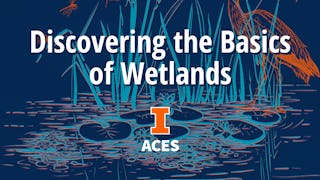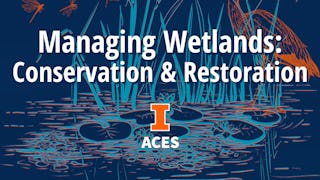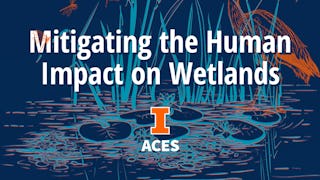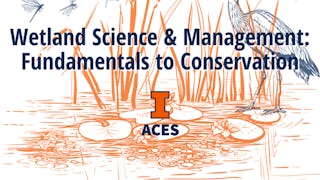In this course, learners will get familiarized with the major components of wetland delineation, including the steps involved and the resources available for remote identification. They will explore the field indicators for hydrology, hydric soils, and vegetation, essential for accurate wetland delineation. The course will cover the best practices for writing wetland delineation reports and the differences between wetland delineation and jurisdictional determination. By the end of the course, learners will have a comprehensive understanding of the processes and indicators used in wetland delineation, enabling them to conduct accurate and effective assessments.


Wetland Delineation Fundamentals
This course is part of multiple programs.

Instructor: Caitlin Bloomer, Ph.D.
Included with
Recommended experience
What you'll learn
Recall the steps involved in wetland delineation and the resources available for remote identification.
Explain the importance of hydric soils and hydrophytic vegetation in wetland delineation, and describe the field indicators used in these components.
Apply your knowledge to identify and assess field indicators for hydrology, hydric soils, and vegetation in real-world wetland environments.
Develop wetland delineation reports, incorporating best practices and addressing problematic situations.
Skills you'll gain
Details to know

Add to your LinkedIn profile
6 assignments
See how employees at top companies are mastering in-demand skills

Build your subject-matter expertise
- Learn new concepts from industry experts
- Gain a foundational understanding of a subject or tool
- Develop job-relevant skills with hands-on projects
- Earn a shareable career certificate

There are 4 modules in this course
In the course orientation, you will become familiar with the course, your classmates, and our learning environment. The orientation will also help you obtain the technical skills required for the course. Then dive into the second part of this module where you will learn the essential steps involved in wetland delineation, discover resources for locating wetlands remotely, and understand the key field indicators of hydrology in wetlands.
What's included
20 videos5 readings2 assignments1 discussion prompt
In this module, you will explore the importance of assessing hydric soils for wetland delineation, learn about the field indicators used for all hydric soils, and delve into specific indicators for sandy or loamy soils. By completing this module, you will gain the skills to identify and evaluate hydric soils, which are crucial for accurate wetland delineation.
What's included
12 videos3 readings1 assignment4 plugins
In this module, you will understand the role of vegetation in wetland delineation, identify field indicators for hydrophytic vegetation, and learn about the sequential tests used to confirm hydrophytic vegetation. By the end of this module, you will be equipped to assess vegetation indicators effectively, ensuring comprehensive wetland delineation.
What's included
15 videos2 readings1 assignment
In this module, you will discuss best practices for writing comprehensive wetland delineation reports, learn how to describe and report problematic situations, and examine the differences between wetland delineation and jurisdictional determination. At the conclusion of this module, you will be ready to complete the final assessment for the course and earn your Coursera certificate!
What's included
11 videos5 readings2 assignments
Earn a career certificate
Add this credential to your LinkedIn profile, resume, or CV. Share it on social media and in your performance review.
Instructor

Offered by
Explore more from Environmental Science and Sustainability
 Status: Free Trial
Status: Free TrialUniversity of Illinois Urbana-Champaign
 Status: Free Trial
Status: Free TrialUniversity of Illinois Urbana-Champaign
 Status: Free Trial
Status: Free TrialUniversity of Illinois Urbana-Champaign
 Status: Free Trial
Status: Free TrialUniversity of Illinois Urbana-Champaign
Why people choose Coursera for their career





Open new doors with Coursera Plus
Unlimited access to 10,000+ world-class courses, hands-on projects, and job-ready certificate programs - all included in your subscription
Advance your career with an online degree
Earn a degree from world-class universities - 100% online
Join over 3,400 global companies that choose Coursera for Business
Upskill your employees to excel in the digital economy
Frequently asked questions
Yes! Although completion of the Coursera course alone is not credit-bearing, it is a required component of a graduate-level Canvas course that can be "stacked" toward advanced credentials such as an academic (transcriptable) graduate certificate or a degree. If you decide to pursue further education, the credits you earn from this course can be applied toward a formal academic program, provided that you meet all the requirements of admission to the certificate or degree. Learn more about the Wetland Science and Conservation Graduate Certificate.
To access the course materials, assignments and to earn a Certificate, you will need to purchase the Certificate experience when you enroll in a course. You can try a Free Trial instead, or apply for Financial Aid. The course may offer 'Full Course, No Certificate' instead. This option lets you see all course materials, submit required assessments, and get a final grade. This also means that you will not be able to purchase a Certificate experience.
When you enroll in the course, you get access to all of the courses in the Specialization, and you earn a certificate when you complete the work. Your electronic Certificate will be added to your Accomplishments page - from there, you can print your Certificate or add it to your LinkedIn profile.
More questions
Financial aid available,

